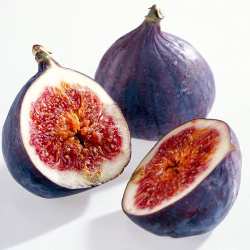Figs Nutrition facts
Figs

Delicious, sweet fig fruit is one of the popular fruits enjoyed since ancient times. Fig is rich in natural health benefiting phytonutrients, antioxidants, and vitamins. Entirely developed and ripe fig features bell or pear shape with succulent, juicy flesh inside. Dried figs, indeed, are a highly concentrated source of minerals and vitamins.
Botanically figs belong to the mulberry family (Moraceae), in the genus: Ficus.
Scientific name: Ficus carica.
The fig tree is native to temperate regions of Asia Minor or Turkey, and today, grown as an important fruit of commerce in the eastern Mediterranean climates, US, and Spain. It is also cultivated as a fruit tree in the home gardens in many other regions as well. During each season, fig produces several hundreds of pear-shaped fruits twice a year, which vary in size, and color depending on the variety.
| Nutrition Principle | Nutrition Value | Percentage of RDA |
|---|---|---|
| Principle | ||
| Energy | 74 Kcal | 4% |
| Carbohydrates | 19.18 g | 15% |
| Protein | 0.75 g | 1.5% |
| Total Fat | 0.30 g | 1% |
| Cholesterol | 0 mg | 0% |
| Dietary Fiber | 2.9 g | 7% |
| Vitamins | ||
| Folates | 6 µg | 1.5% |
| Niacin | 0.400 mg | 2.5% |
| Pantothenic acid | 0.300 mg | 6% |
| Pyridoxine | 0.113 mg | 9% |
| Riboflavin | 0.050 mg | 4% |
| Thiamin | 0.060 | 5% |
| Vitamin A | 142 IU | 5% |
| Vitamin C | 2 mg | 3% |
| Vitamin E | 0.11 mg | 1% |
| Vitamin K | 4.7 µg | 4% |
| Electrolytes | ||
| Sodium | 1 mg | 0% |
| Potassium | 232 mg | 5% |
| Minerals | ||
| Calcium | 35 mg | 3.5% |
| Copper | 0.070 mg | 8% |
| Iron | 0.37 mg | 5% |
| Magnesium | 17 mg | 4% |
| Manganese | 0.128 mg | 5.5% |
| Selenium | 0.2 µg | <1% |
| Zinc | 0.15 mg | 1% |
| Phyto-nutrients | ||
| Carotene-ß | 85 µg | -- |
| Lutein-zeaxanthin | 9 µg | -- |